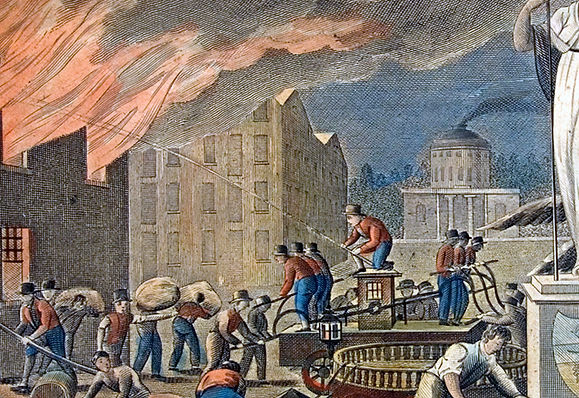FIRE INSURANCE
New York Fire Patrol
1780–Present

RELATED ARTICLE: Marks of Assurance
Early Salvage Organizations
In Manhattan, the earliest salvage organization began when the “Hand in Hand” company was formed in 1780. This company, along with others established soon after, worked to prevent damage by smoke and water in burning buildings. The two main tools were stout linen bags, used to carry away property, and bed keys, used to disassemble beds – a valuable piece of property during that time. It was not until the “Mutual Assistance Bag Company” was formed in 1803 that any salvage organization was conspicuously connected with fire insurance companies.

Patrolmen seen dragging valuables out of a house on fire.
Paid Fire Patrol
In 1835, the Fire Police was created and past members of the volunteer fire department patrolled the city at night, attending all fires. During this time, patrolmen used hand-drawn wagons to carry their brooms, buckets, and protective covers. In 1853, the patrol committee of the New York Board of Fire Insurance Companies created the first code of rules. A second patrol unit was created in 1855, and three years later, a day force with two men was appointed to both companies.
The New York Fire Patrol (NYFP)
In 1867, the Fire Patrol was chartered as a paid fire salvage service managed by the New York Board of Fire Underwriters. The charter stipulated that companies insuring property within the city had to pay the Board an annual tax, which was used to pay the patrolmen. Within three years, a permanent force was established, with a part-time auxiliary force for night service.
The Fire Patrol at Fires
A patrolman’s job was essentially the same since the beginnings of fire salvage work – to protect and preserve property and life at and after a fire. The NYFP helped decrease the cost of insurance claims and protect important records and electrical equipment. At fires, patrolmen worked alongside firefighters. Because they were civilians, patrolmen took orders from the FDNY commanding officer, who ensured it was safe for patrolmen to enter a burning building. Just like the FDNY, the NYFP had its own training school where patrolmen learned techniques of fire salvage, first aid, and forcible entry. Their main job was to protect contents on floors below a fire from being damaged by water used to extinguish fire on floors above. Some of the Patrol’s tools included tarpaulins, brooms, mops, sand, sawdust, and forcible entry tools. The NYFP worked primarily at commercial structures, regardless of whether the property was insured. Because the cost of the NYFP was funded by insurance premiums, policy holders were paying for a service that also benefited the uninsured. The National Board of Fire Underwriters advised local chapters to discontinue patrol services and let municipal firefighters take care of salvage work. Several patrol companies in New York were disbanded starting in the 1930s. By 1960, only three cities had active patrols. NYFP companies, disbanded in 2006, were the last fire patrols in the U.S.




